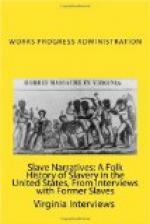“My grandfather’s mother[HW: ?] had a chair and that was hers only. She was named Senia and was about eighty years old. We burned nothing but pine knots in the hearth. You would put one or two of those on the fire and they would burn for hours. We were all in bed and had been for an hour or two. There were some others sleeping in the same room. There came a peculiar knocking on grandmother’s[HW: great grandmother?] chair. It’s hard to describe it. It was something like the distant beating of a drum. Grandmother was dead, of course. The boys got up and ran out and brought in some of the hands. When they came in, a little thing about three and a half feet high with legs about six or eight inches long ran out of the room.
Ku Klux Klan
“Whenever there was a man of influence, they terrorized him. They were at their height about the time of Grant’s election. Many a time my mother and I have watched them pass our door. They wore gowns and some kind of helmet. They would be going to catch same leading Negro and whip him. There was scarcely a night they couldn’t take a leading Negro out and whip him if they would catch him alone. On that account, the Negro men did not stay at home in Sumter County, South Carolina at night. They left home and stayed together. The Ku Klux very seldom interfered with a woman or a child.
“They often scared colored people by drinking large quantities of water. They had something that held a lot of water, and when they would raise the bucket to their mouths to drink, they would slip the water into it.
White Caps
“The white caps operated further to the northwest of where I lived. I never came in contact with them. They were not the same thing as the Ku Klux.
Voting
“In South Carolina under the Reconstruction, we voted right along. In 1868 there were soldiers at all of the election places to see that you did vote.
Career Since the War
“In 1881 I married. The year after that, in ’83,[HW: ?] I merchandised a little. Then I got converted. I got it in my head that it was wrong to take big profits from business, so I sold out. Then I was asked to assist the keeper of the jail.
“In 1888 I went to school for the first time. I was then twenty-six years old. By the end of the first term, I knew all that the teacher could teach, so he sent me to Claflin University. I left there in the third year normal.
“When I returned home, I taught school, at first in a private school and later in a public school for $15 a month.
“A man named Boyle told me that he had some ground to sell. I saved up $45, the price he asked for it. When I offered it to him, he said that he had decided not to sell it. I went to town and spent my $45. A few days later, he met me and offered me the place again. I told him I had spent my money. He then offered it to me on time. There was plenty of timber on the place, so I got some contracts with a man named Roland and delivered wood to him. When I went to collect the money, he said he would not pay me in money.




